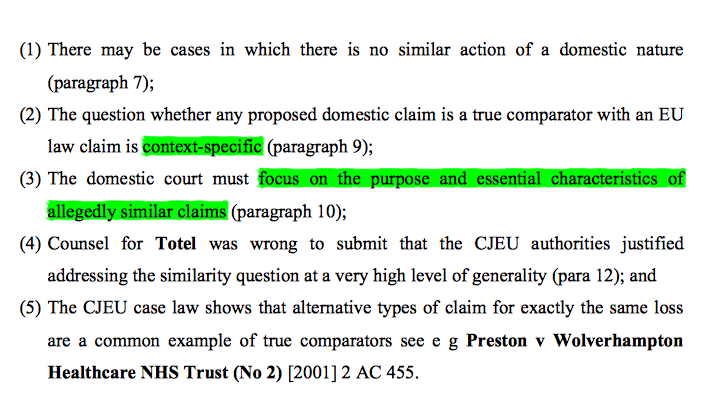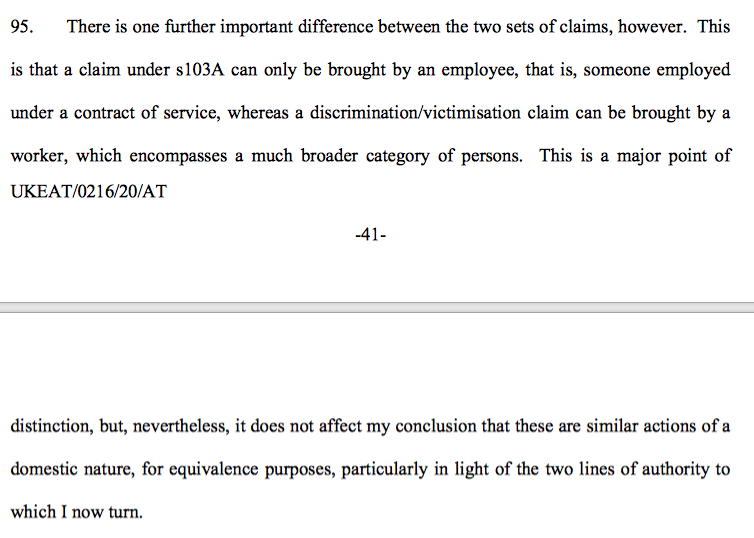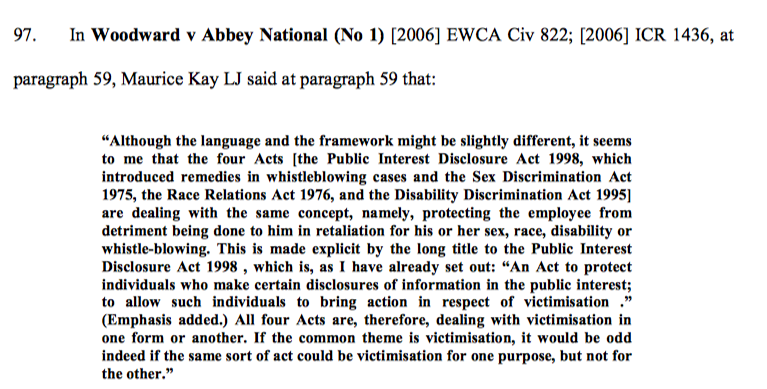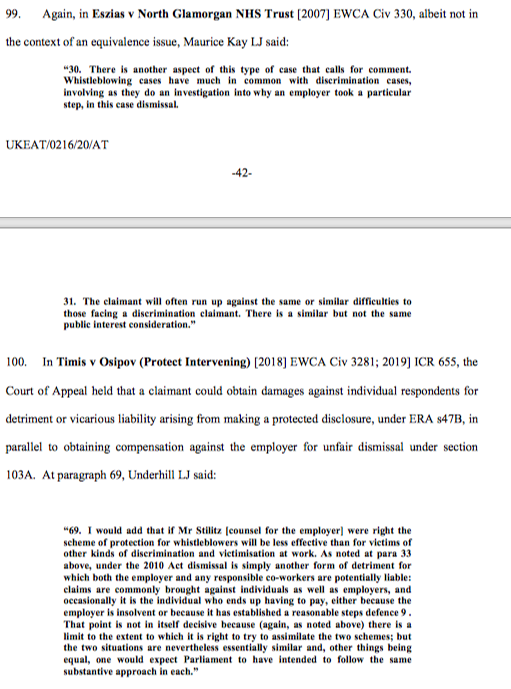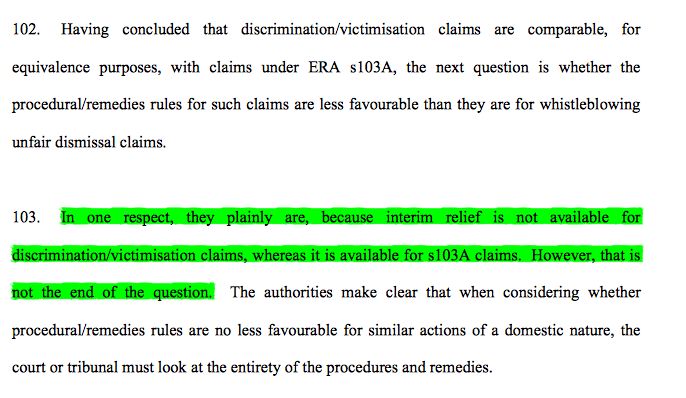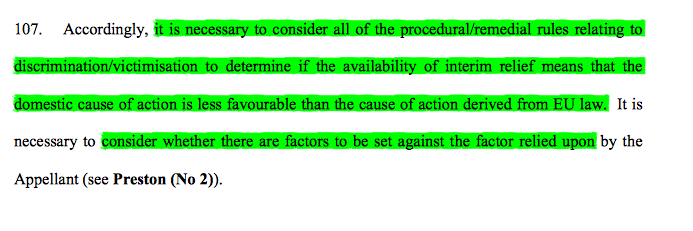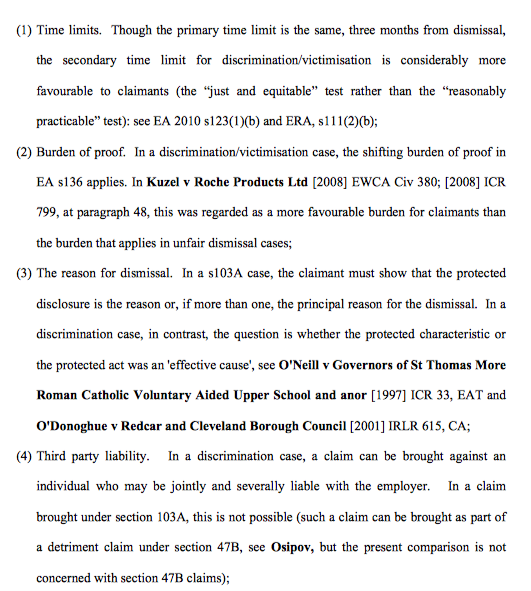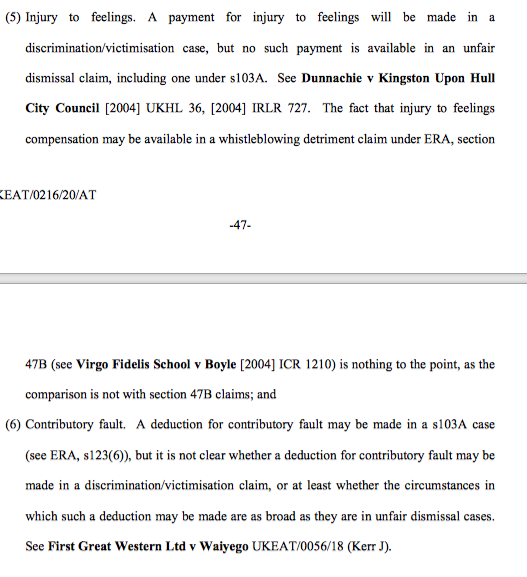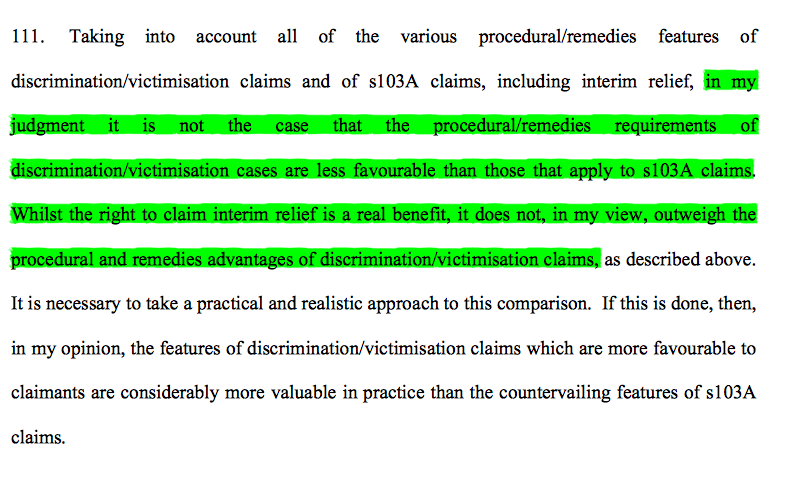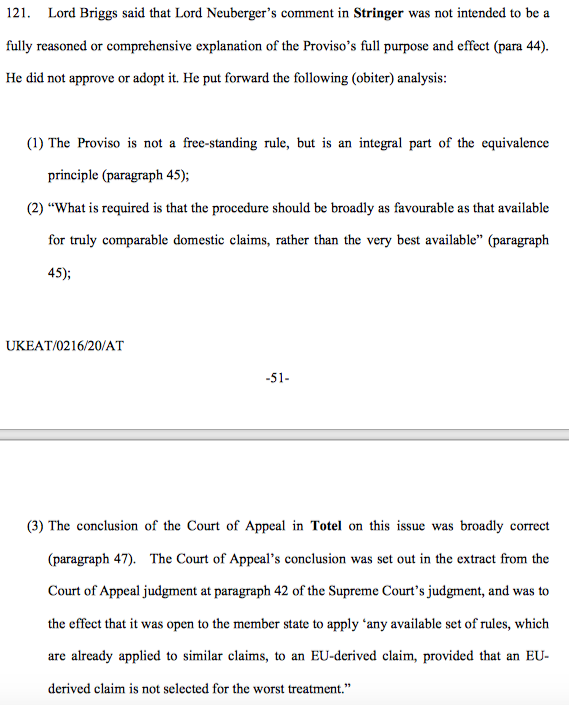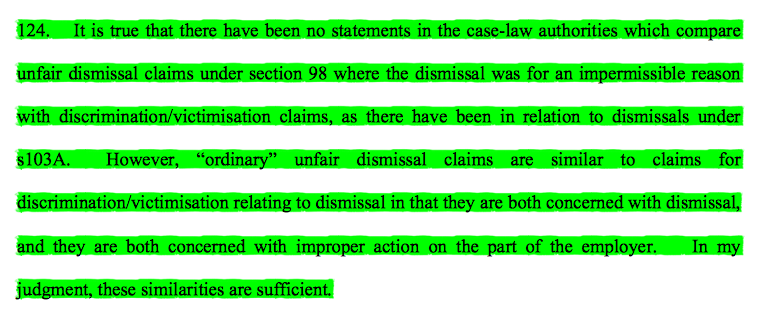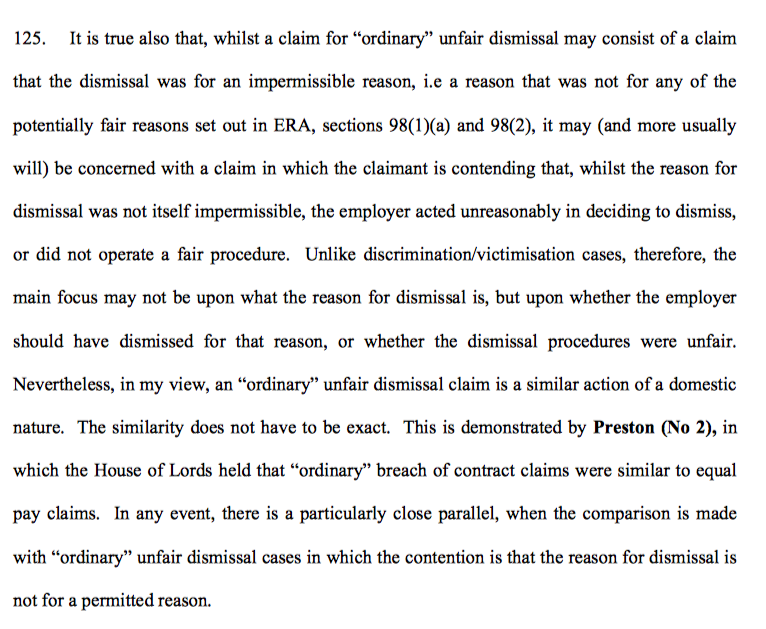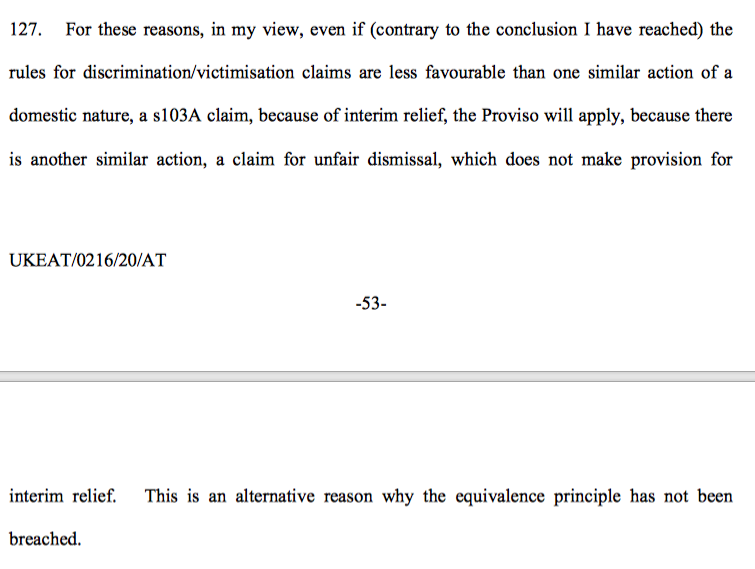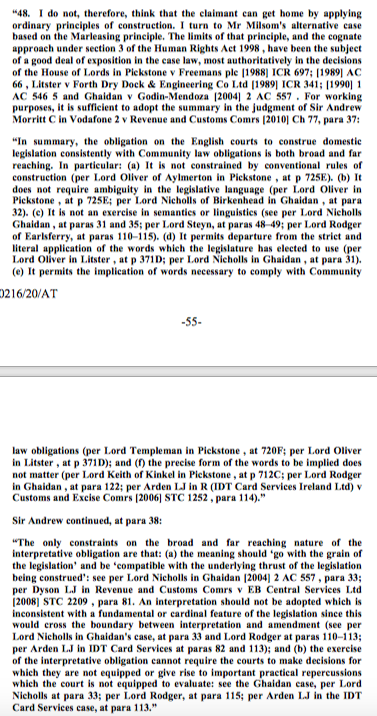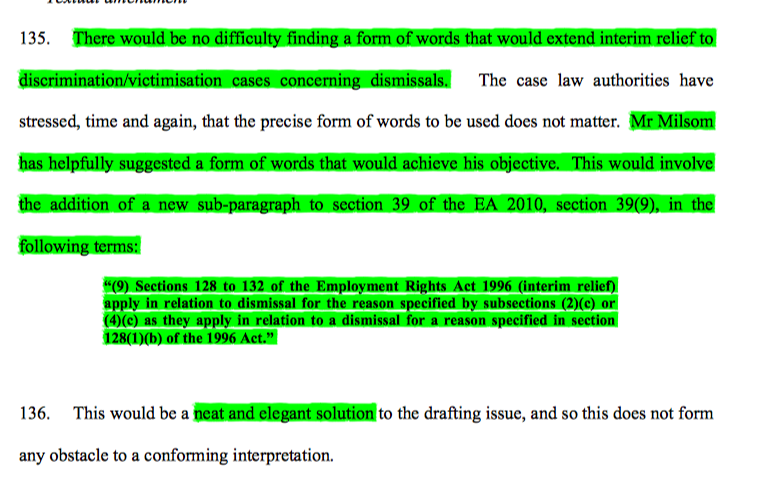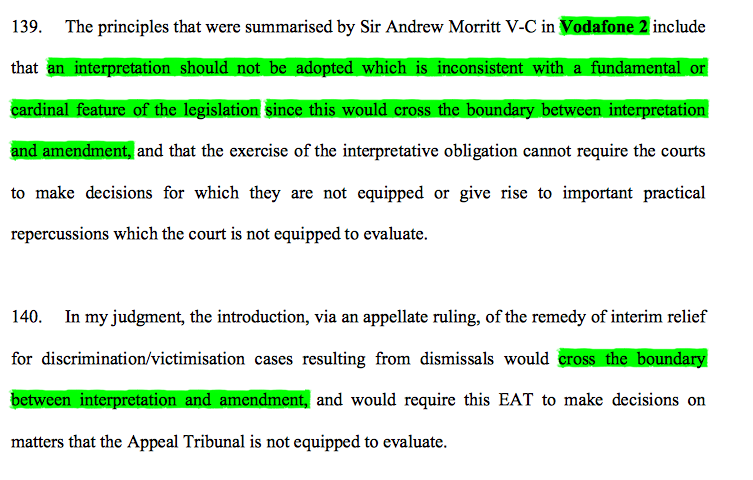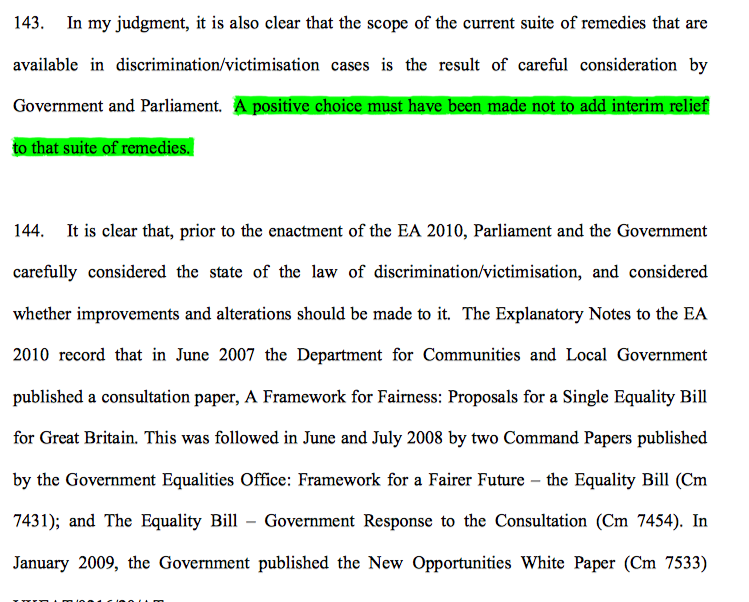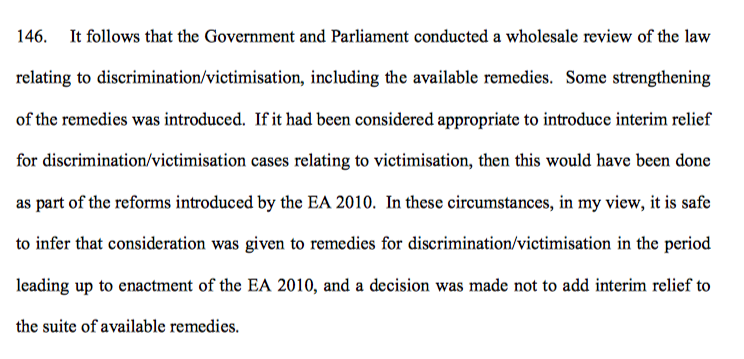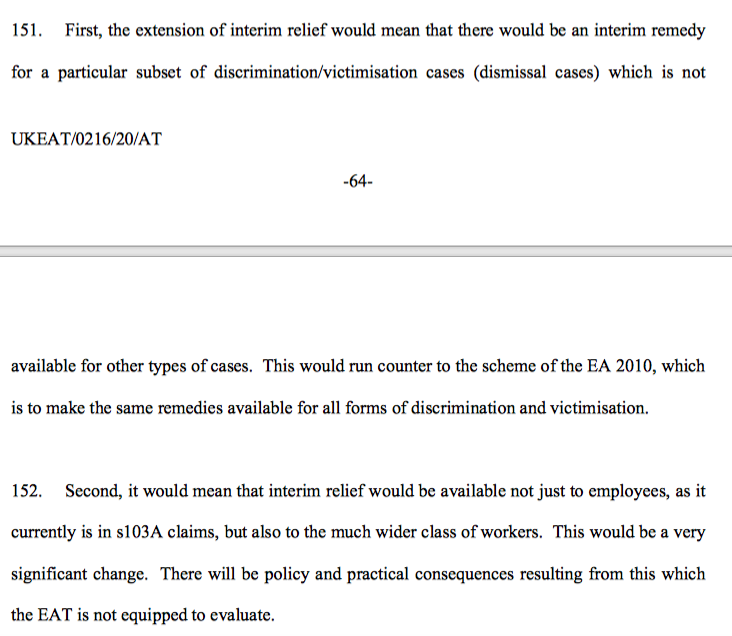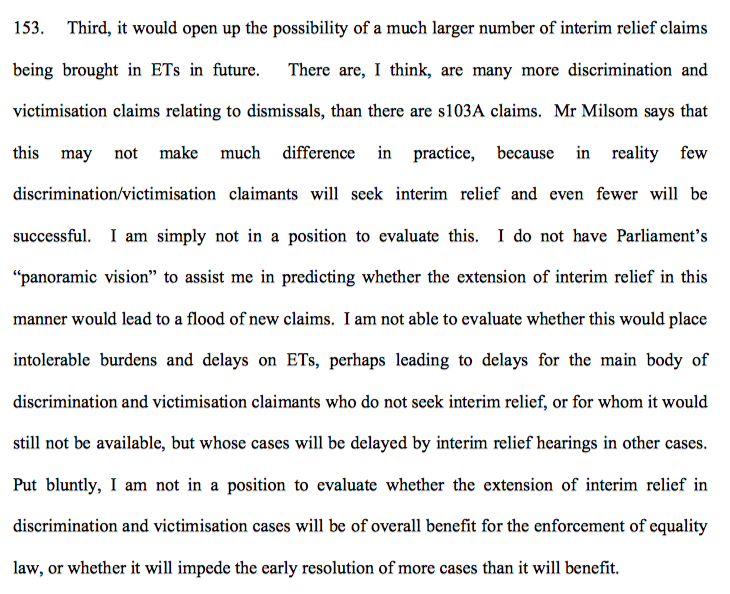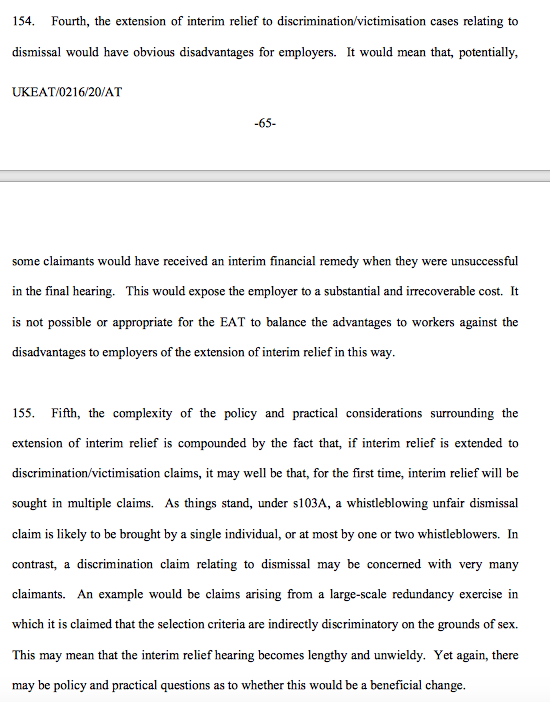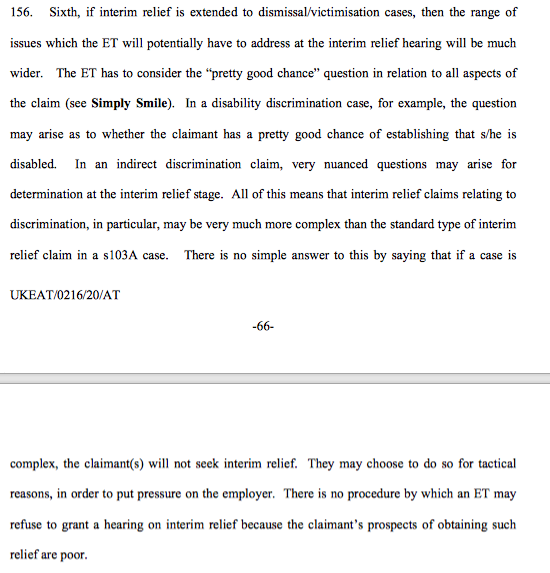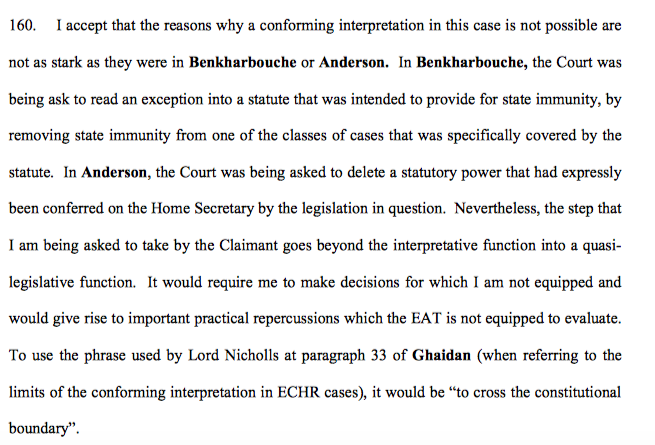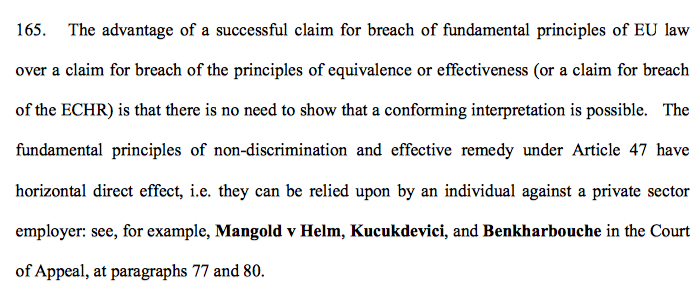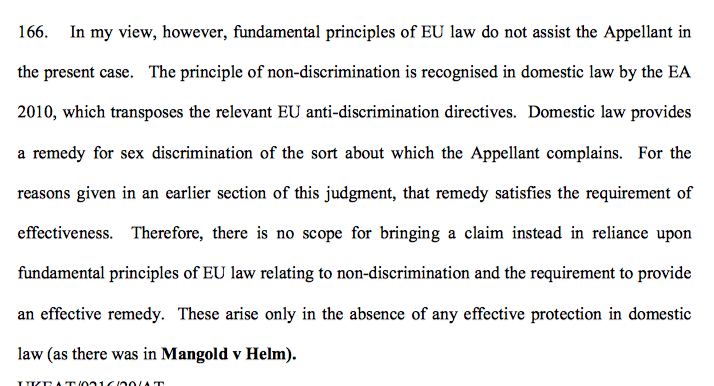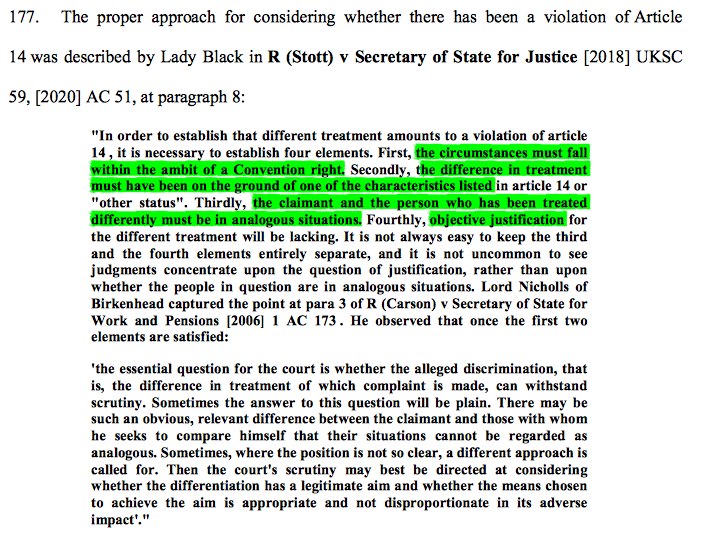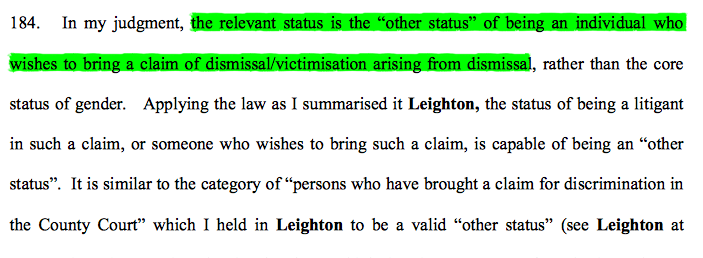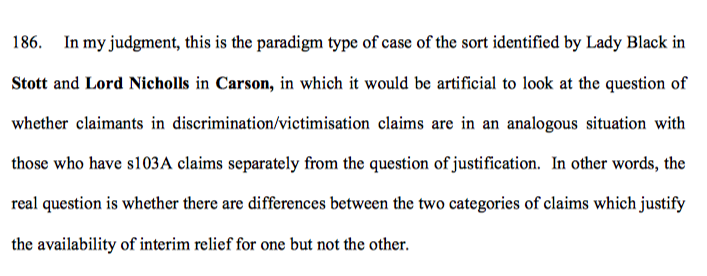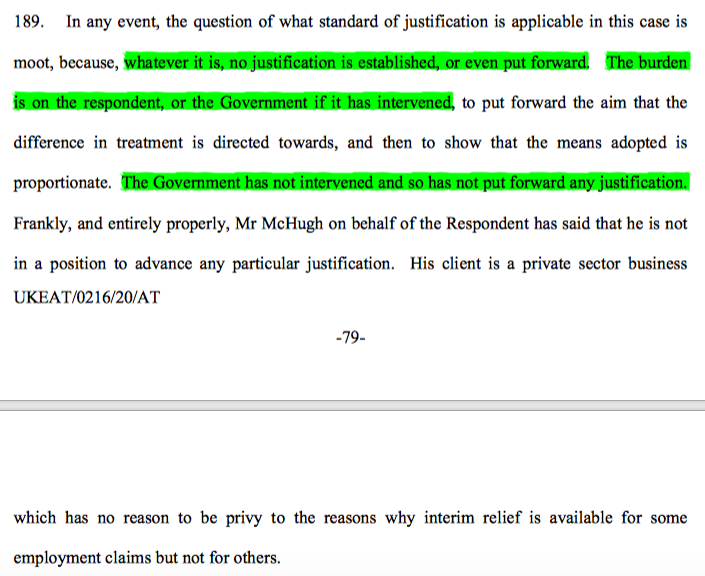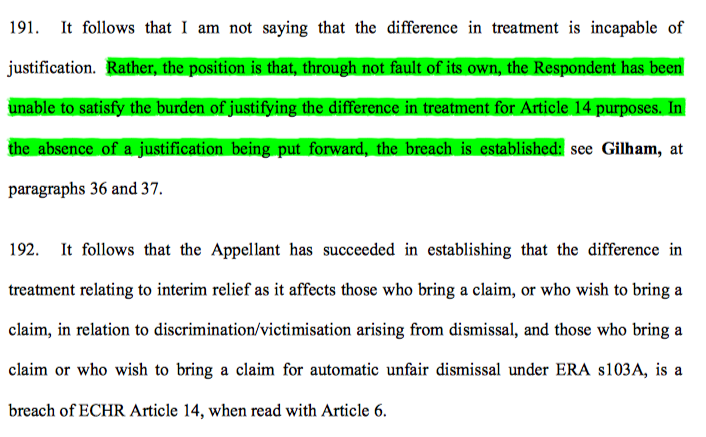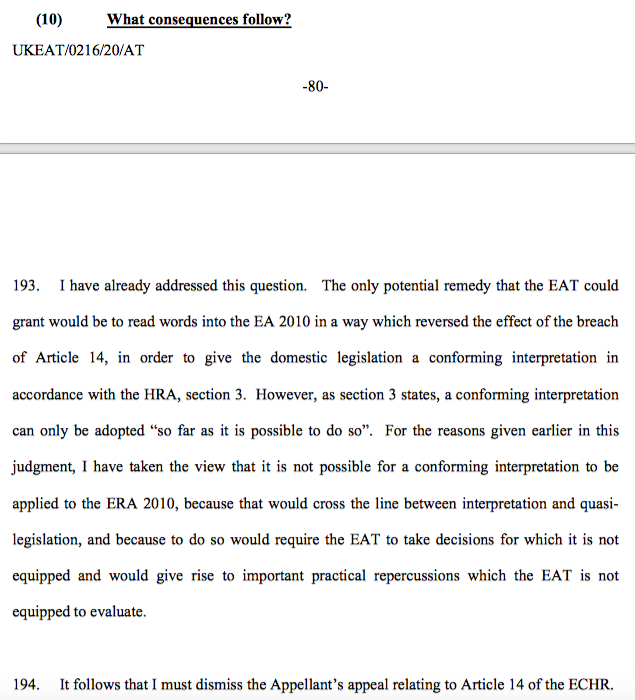1/ Steer v Stormsure - does it breach EU law &/or the ECHR that there's no interim relief remedy available for discriminatory dismissals under the EqA even though it's available for whistleblower dismissals under the ERA? The EAT said no to EU, & yes to ECHR, but... #ukemplaw
2/ But it would be inappropriate for the EAT to read in words to the EqA to add in the remedy as that would amount to quasi-legislation. Cavanagh J gave permission to appeal to the CA to persuade that Court to issue a declaration of incompatibility (or to read words in).
3/ The facts are short. S's case is she was employed for about 4 months in 2020. She claimed she was subject to sexual harassment. That was inadequately investigated. She sought to work from home as a safeguard. The R was reluctant, making comments re juggling childcare duties.
4/ The R then allowed her to wfh but insisted she load up monitoring software, & then cut her working hours to 60% due to childcare reasons. S claimed that was a dismissal (Hogg v Dover) or alternatively she claimed to have been constructively dismissed.
5/ S brought a claim which included that her dismissal was, inter alia, directly discriminatory or victimisation (with the grievance as the protected act) & claimed entitlement to interim relief under the ERA & the EqA.
6/ The interim relief claim was listed but only for consideration of the ERA arguments, with the ET holding it had no jurisdiction even to consider the EqA arguments (!). On application for review, the ET held fast to that position (even with the EHRC backing the application).
7/ Hence the interim relief application ended up swiftly before the EAT. The EU arguments were (i) effectiveness; (ii) equivalence & (iii) breach of the Charter. The ECHR arguments were of breach of A14 read with A 6, 8 &/or A1P1.
8/ Cavanagh J starts his consideration of the law by providing a history of interim relief, beginning with the Employment Protection Act 1975, which protected against dismissal for trade union membership & authorised trade union activities.
9/ As the NICA put it in the Bombardier v McConnell case, the purpose of those initial provisions was to swiftly stave off an atmosphere of suspicion leading to industrial unrest.
10/ Cavanagh J went on to list a host of subsequent legislative entrants to the right to claim interim relief, most notably the categories under s.128 ERA & the update to the EPA 1975 under TULR(C)A, but also under the ERA 99 & Employee Study & Training (Procedural) Regs 2010
11/ Looking 1st at the EU principle of effectiveness, S asserted interim relief provided 4 substantive benefits: (i) restoration of employment; (ii) swift redress; (iii) avoidance of cost; (iv) swift access to an effective financial remedy. The EAT thought (ii) & (iv) relevant.
12/ The EAT noted 2 further relevant benefits: (v) The lack of recoupment if ultimately unsuccessful at trial; (vi) the pressure placed on the employer to move swiftly to settle. The EAT didn't think restoration of employment relevant as it rarely in fact happens.
13/ The EAT rejected the effectiveness argument. The question wasn't whether an added remedy could be given to victims of discriminatory dismissals, but whether the suite of remedies provided was an effective one. Irrespective of delays, compensation was effective.
14/ The CJEU's judgment in Marshall (No. 2) effectively provides the final nail in the effectiveness coffin, by both dealing with compensation as effective remedy & also in noting the dampening of delay's damage by the requirement to pay interest.
15/ Moving on to equivalence, the argument there was 1 of equivalence between whistleblowing & discrimination/victimisation/harassment dismissals. 3 questions need determining: (1) similarity; (2) whether the EqA procedures/remedies are less favourable, & (3) [see next tweet]...
16/ (3) Whether there is a similar domestic claim to the EU claim for which the procedure/remedies are no more favourable than for the EU claim even if there are other domestic claims which do have more favourable procedures and remedies.
17/ On similarity, the Supreme Ct gave guidance in Totel v Revenue & Customs, most importantly that it's a context-specific comparison focusing on the purpose & essential characteristics of the comparator species of claim. It's not enough that there's superficial similarity.
18/ The EAT accepted the claims were similar. Both arise by less favourable treatment through dismissal for an impermissible reason. While there are procedural differences, they don't take away from the sufficient similarity of the underlying claim.
19/ Nor does the fact that a s103A ERA claim is brought by an employee under s.230 whereas an EqA claim can be brought by a worker. In finding similarity, the EAT noted a host of claims expressing similarities, including Woodward, Eszias & Osipov.
20/ This is as good a money as any to take a halfway break in this thread, lest I commit the cardinal sin of picking up children late from camp/nursery (exceptions under the new Covid Regulations - but that's another thread! - back to this thread this evening...)
21/ Right, back for Pt 2. After finding similarity, the EAT needed to look next at whether the procedural/remedy rules for EqA dismissals were less favourable than under s.103A. The lack of interim relief as a remedy for the former could only be part of the answer.
22/ One needs to look at the whole package rather than picking out individual aspects (the opposite approach to looking at a contract to see whether the terms are less favourable for an equal pay claim).
23/ Cavanagh J pointed to 6 advantages under the EqA over s.103A ERA: time limit extensions, shifting burden of proof, effective cause as against sole or principal reason, individual's liability (available under s.47 but not s.103A), injury to feelings, contrib fault position.
24/ Looking at the overall position, the EAT didn't consider the package for EqA dismissals less favourable than for s.103A dismissals.
25/ The EAT thus didn't need to look at the 3rd question, but did so in case wrong on q.2. The essence of the proviso is that the procedure/remedy should be broadly as favourable as truly comparable domestic claims rather than as per the best available domestically.
26/ Noting interim relief wasn't available for ordinary unfair dismissal claims, Cavanagh considered whether s.98 claims were comparable domestic claims to the EU right not to be dismissed through discrimination/victimisation. He found them sufficiently similar.
27/ Given that finding, and given the lack of interim relief as a remedy for ordinary unfair dismissal, the proviso applied and S would have failed on q.3 if she hadn't already failed on q.2.
28/ Notwithstanding this rejection, the EAT moved on to consider whether a right to interim relief could be read into the legislation, applying the well-known Marleasing principle of statutory construction, setting out the characterisation in Blackwood (another @MilsomChr case)
29/ Noting the broadness of Marleasing, the need not to be wedded to strict or literal construction & the main outer limit being the requirement not to go against the grain of legislation, the EAT set out 8 cases where Marleasing had been applied.
30/ Disappointingly, @MilsomChr only appeared in 3 of the 8 (Blackwood, Gilham & the most important of all, Rowstock (where I was on the losing side), though another 3 were before he was called, so he can be forgiven for those!
31/ Whilst Cavanagh J set those out to show the breadth of the power under Marleasing, he went on to note other cases where the courts have found breach of an EU or convention right but declined to apply a conforming interpretation to make good that breach.
32/ If the EAT had found a breach of EU law, it would have declined in this case as well. Whilst noting @MilsomChr's elegant legislative solution in a new s.39(9), Cavanagh J considered that reading in the new provision would have crossed the boundary to quasi-legislation.
33/ He noted the deliberate decision to have separate remedy regimes for unfair dismissal & discrimination, with careful consideration during the Equality Act's legislative path about whether to make any alterations. He presumed a positive decision not to add interim relief.
34/ Cavanagh J notes a variety of changes that were made to the law under the EqA re remedies, and concluded that there was a wholesale review & had the government wanted interim relief as part of the protection under the EqA, they would have provided it.
35/ To add in interim relief would be to act inconsistently with the legislative scheme and to endanger the balance struck by Parliament. It would imbalance EqA remedies (providing interim relief to only some breaches), & would widen availability of interim relief to workers.
36/ There would be the possibility of a flood of new interim relief applications, something that the EAT was at the very least not in a position to assess (personally, I doubt this - it's rare for parties to get their act in order by the 7-day deadline).
37/ There would be disadvantages for employers - the non-recoupment of interim relief awards is unparalleled within the EqA suite of remedies. It could also be a remedy open - for the 1st time - in large multiple claims. Applying the standard of proof may also be more difficult.
38/ Crucially, it may also impact on the balance of power in litigation between claimant and respondent, making it more likely that respondents would feel pressure to settle claims they would not otherwise have settled, even unmeritorious ones.
39/ None of these are necessarily bad things, but the EqA scheme is an intricate one and the EAT considered it was being asked to cross the boundary & to step into the realms of quasi-legislation - even if not to step very far into that realm. It wasn't prepared to do this.
40/ An alternative argument raised by S was whether the absence of interim relief under the EqA violated fundamental EU principles, namely the non-discrimination principles fleshed out in the Charter of Fundamental Rights, which should be given horizontal direct effect.
41/ That was dealt with swiftly. Given the failure of the effectiveness arguments, this argument had to fail as well. A remedy for sex discrimination is provided under the EqA & it is an effective remedy, hence the non-discrimination principles are upheld.
42/ The EAT finally moved to the ECHR arguments. The claim was of breach of Art 14 with Art 6, 8 or A1P1 rather than standalone breach of any of the latter. Under the discrimination provision of Art 14, reliance was placed on "other status" as the characteristic.
43/ The 4 part test for an Art 14 case is described in Stott: (i) ambit of another Article; (ii) within a characteristic; (iii) different treatment from someone in an analogous situation; (iv) objective justification.
44/ Ambit & status weren't in dispute. Here the status was wishing to bring a claim of discrim/victimisation arising from a dismissal (there's a typo in para 184 but it's clear what is meant). Cavanagh J disregarded an alternative submission on gender as relevant status here.
45/ On the question of analogous status, Cavanagh J would have welcomed government submissions on the strictness of scrutiny to be applied: a conventional proportionality test or not interfering unless treatment was manifestly without reasonable proportion.
46/ Cavanagh J looked at that question at this stage because this was a case where analogous situation & justification should be considered together - it would be artificial to separate them. The Government not taking part meant justification was never advanced.
47/ Whilst it wasn't impossible that there may be a justification available to the government, none had been put forward & it wasn't the EAT's place to speculate on justification and thus the breach of Art 14 was established.
48/ However, the remedies for that breach would either be (i) a conforming interpretation, or (ii) a declaration of incompatibility. The EAT wasn't prepared to do the former (for reasons already explained) & lacked jurisdiction re the latter. Hence the appeal was dismissed.
49/ However, in those circumstances Cavanagh J inevitably gave permission to appeal. S can try to persuade the CA to adopt a conforming interpretation or otherwise to make a declaration. The Government will now doubtless turn up to raise some justification points for the 1st time
50/ Finally, for EU law bods, & purely obiter in the event, Cavanagh J considered near the start of his judgment the jurisdictional position re the Withdrawal Act & 31.12.20. I'll not recite it here but it's paras 10-13 for those who are keen.
51/ It's a quite brilliant judgment, with such clarity of thought, doubtless helped by some clear and brilliant written & oral submissions. Keep an eye out for the appeal, though there may be lobbying opportunities under the forthcoming Employment Bill first.
52/ For those who've reached the end of this 52 tweet thread, here's the link to the judgment: https://www.bailii.org/uk/cases/UKEAT/2020/0216_20_2112.html #ukemplaw

 Read on Twitter
Read on Twitter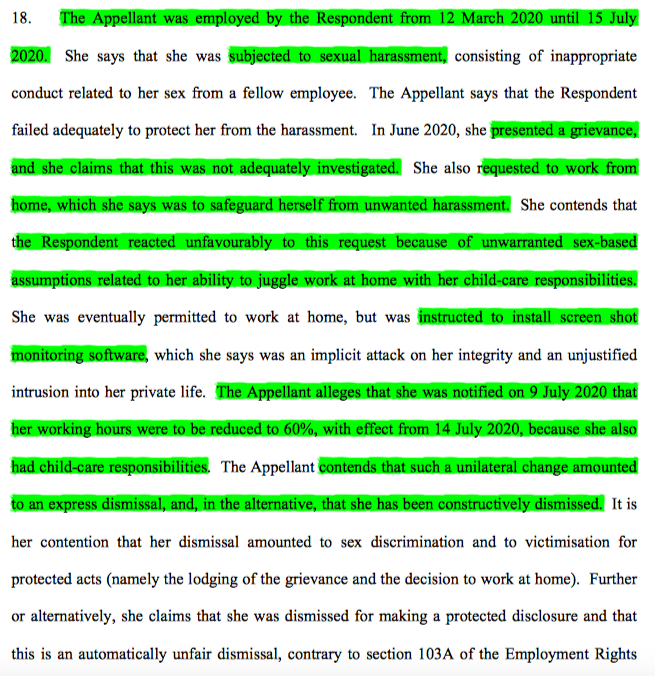
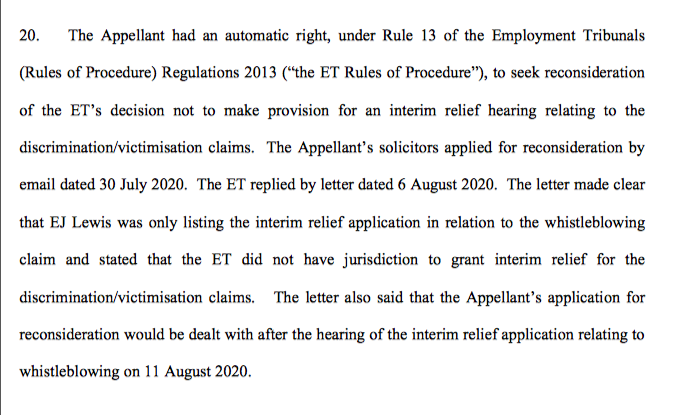
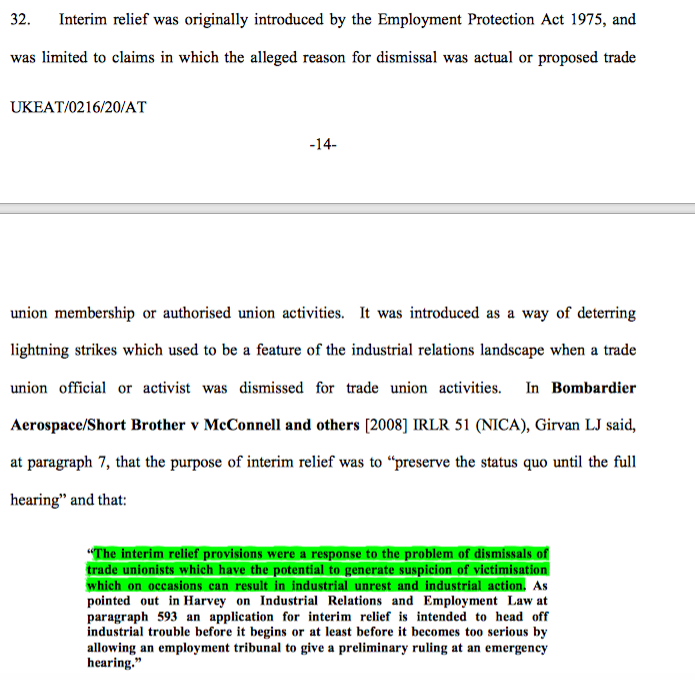
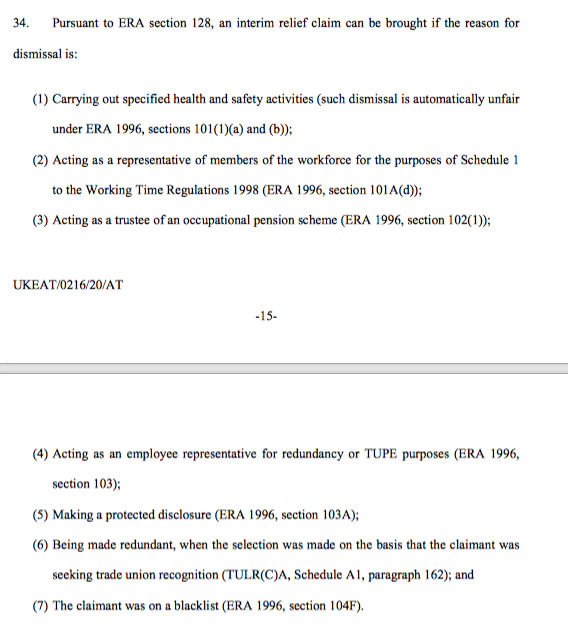
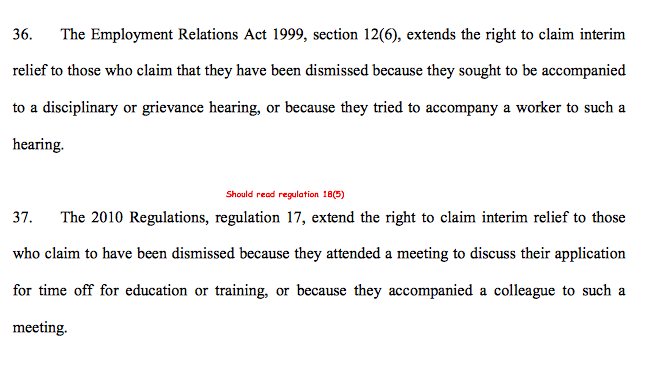
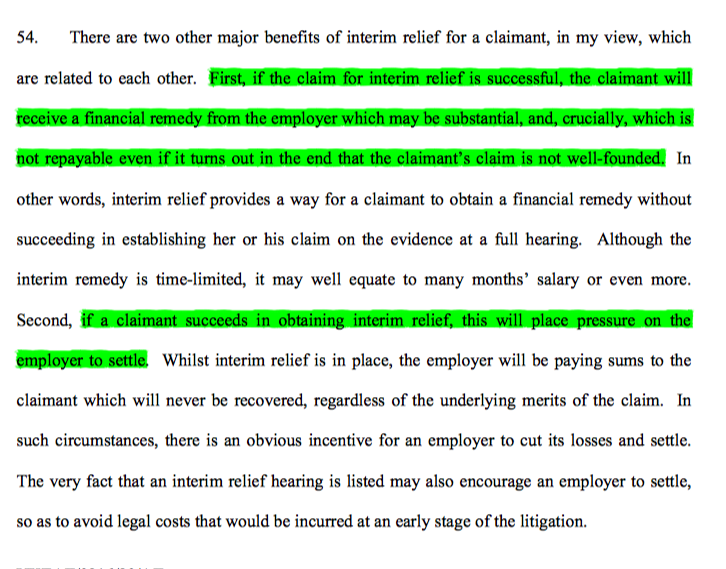
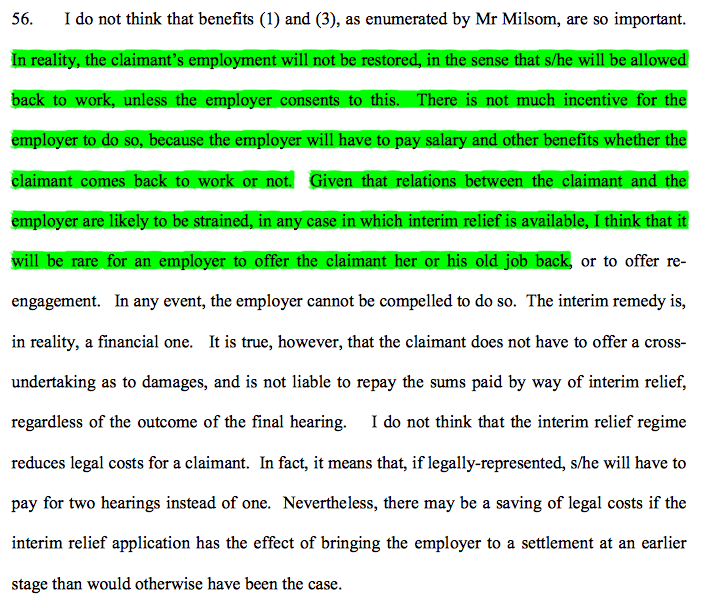
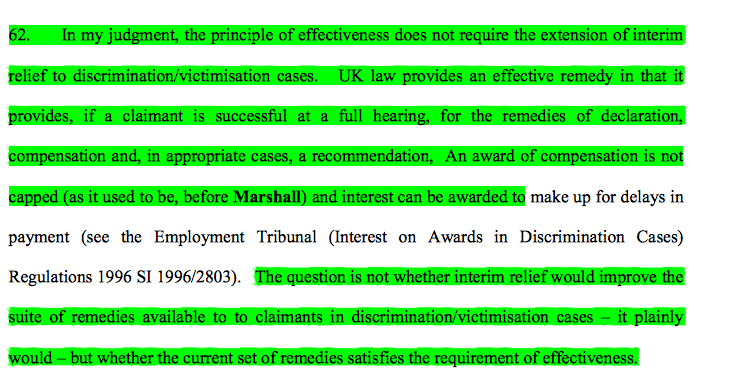
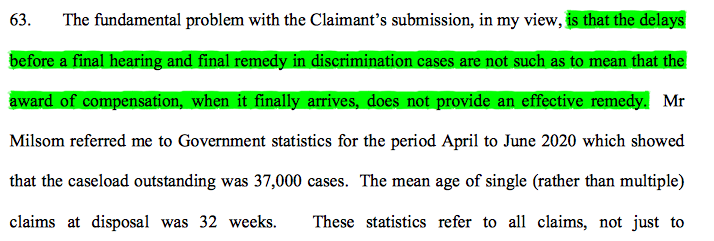
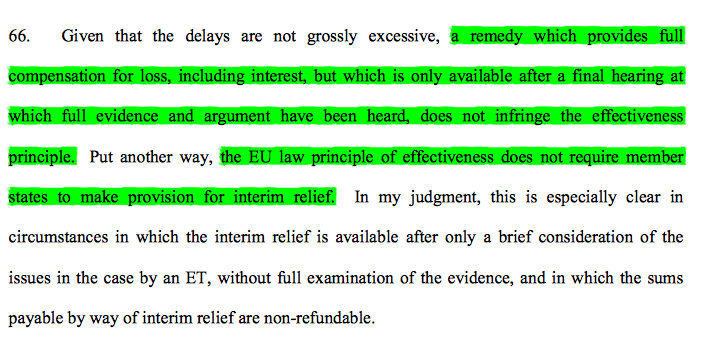
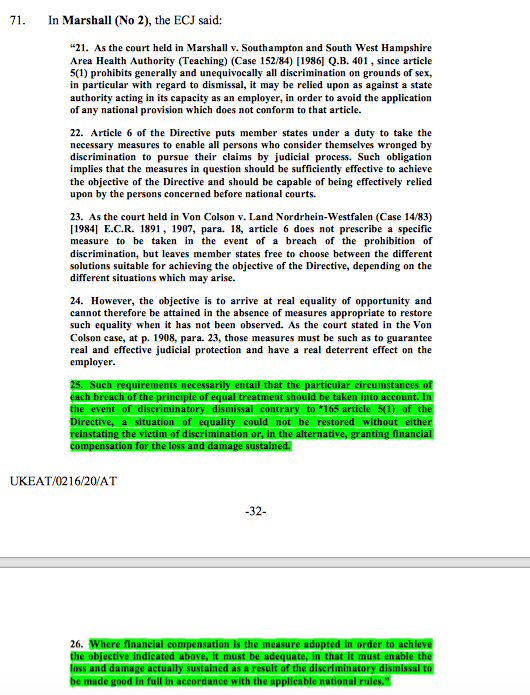

![15/ Moving on to equivalence, the argument there was 1 of equivalence between whistleblowing & discrimination/victimisation/harassment dismissals. 3 questions need determining: (1) similarity; (2) whether the EqA procedures/remedies are less favourable, & (3) [see next tweet]... 15/ Moving on to equivalence, the argument there was 1 of equivalence between whistleblowing & discrimination/victimisation/harassment dismissals. 3 questions need determining: (1) similarity; (2) whether the EqA procedures/remedies are less favourable, & (3) [see next tweet]...](https://pbs.twimg.com/media/EpxV6FOXYAEd4cB.png)

